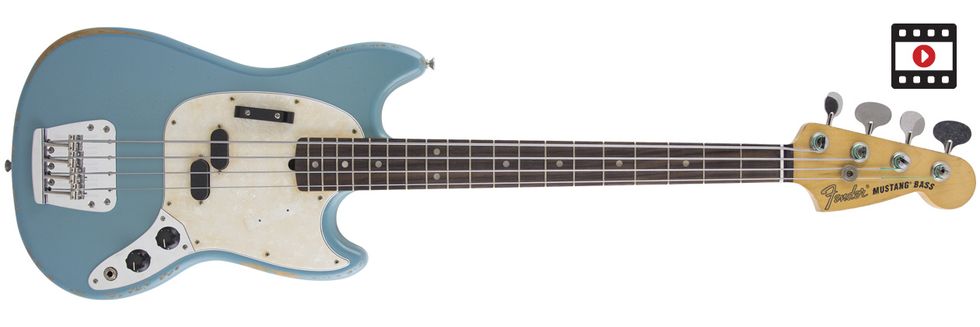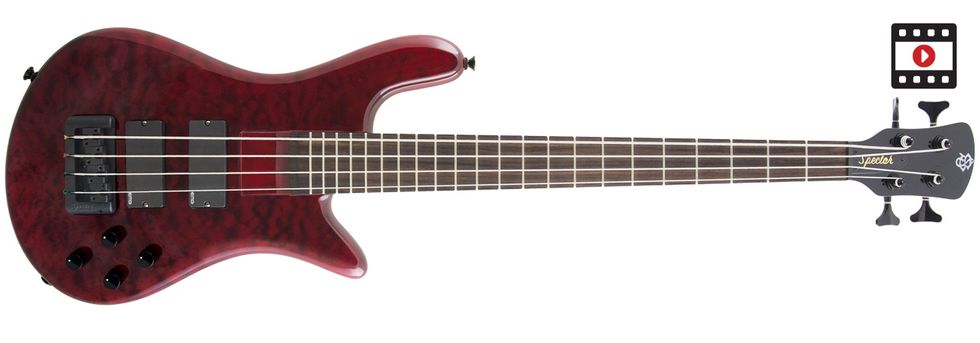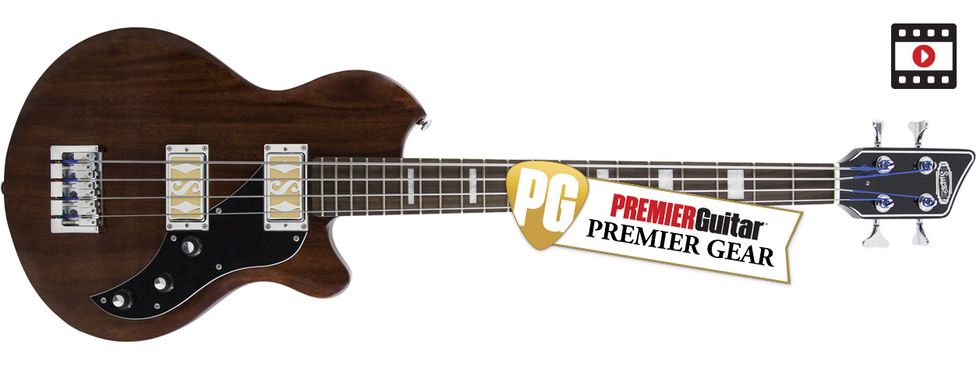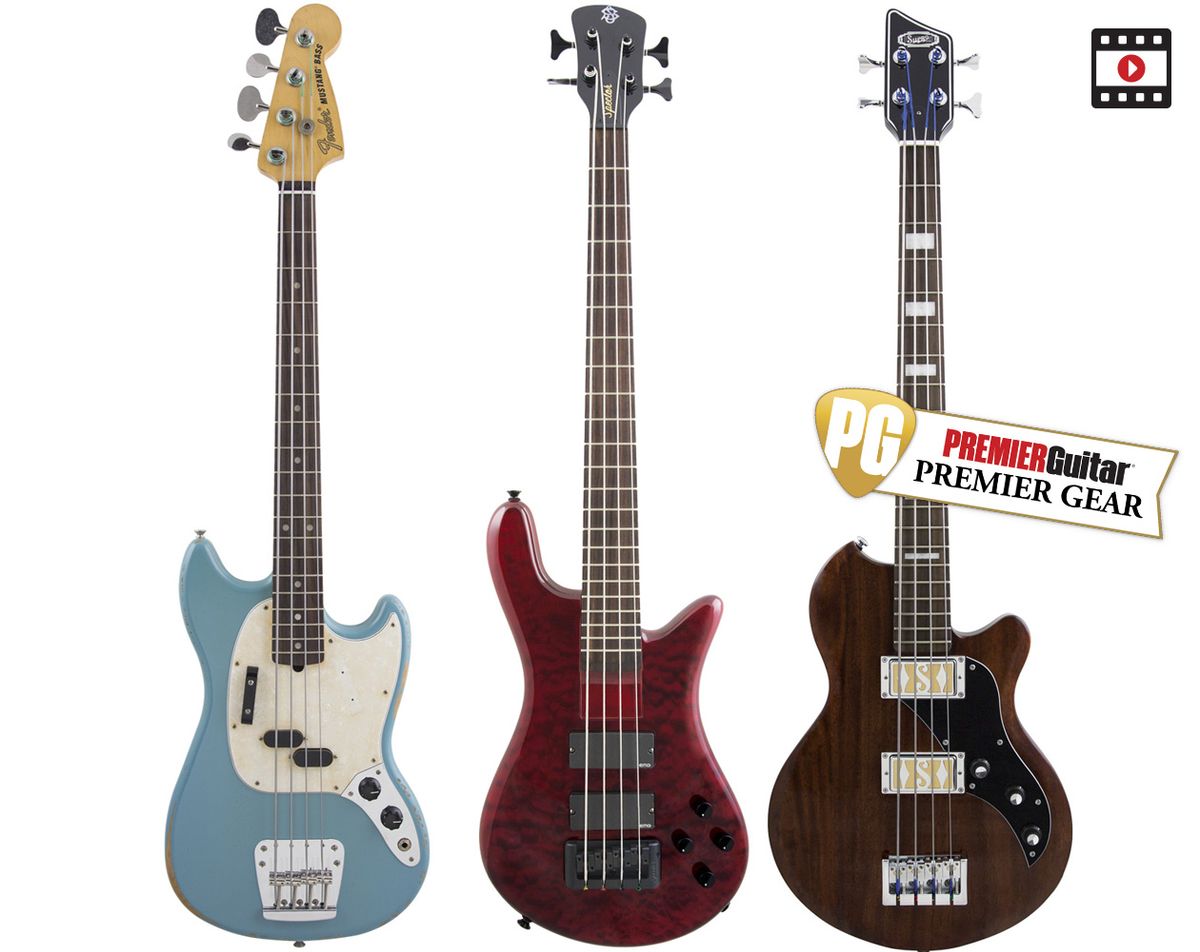We check out three downsized rumblers—the Fender JMJ Road Worn Mustang, Spector Bantam 4, and Supro Huntington II.
When Leo Fender introduced his P bass in 1951, he found 34"to be the optimum scale length, especially for all the upright bassists who suddenly found themselves transitioning to electric. But while a 34"scale length would become the standard in bass design—and still is—many of Fender’s competitors back in the day were content with a shorter string length, as exemplified by the Hofner 500/1 and Gibson EB-0. Fender eventually followed suit, releasing downsized low-enders like the Mustang and Musicmaster, and future builders then took these templates and adventurously sought to build better instruments—assuring the diminutive darlings a place in bass history.
Today, anything less than 31"from nut to bridge is considered “short-scale.” And while some might be tempted to dismiss them as cute instruments that are somehow inferior, informed players know better. But what exactly is it about short-scale basses that makes them so much more than a novelty? Is it playability? Tone? A travel-friendly package? The answer is a resounding yes to allof these. Bassists of all persuasions—from Paul McCartney to Tina Weymouth and Stanley Clarke—have relied on short-scales as their go-to bass. Former Roots bassist Owen Biddle—a fine example of low-end badassery—regularly slayed Late Night with Jimmy Fallon viewers with his CallowHill OBS. What’s more, most studio pros have a short-scale bass in their arsenal because of how well they tend to sit in a mix. And while some poor instruments of yore have inspired naysayers to insist that short-scale basses have floppy string action and inconsistent intonation, many devout, highly experienced players would argue otherwise. That’s largely due to much-improved modern construction techniques.
With both budget and boutique brands introducing instruments that satisfy a wide variety of sonic tastes and looks, it’s an exciting time to be in the market for a short-scale bass. And while there are manyawesome options for the short-scale consumer, the three instruments we’re reviewing here—Fender’s JMJ Road Worn Mustang, Spector’s Bantam 4, and Supro’s Huntington II—are emblematic of the quality and diversity in today’s offerings.
Click to the next page or choose your bass below:
Fender JMJ Road Worn Mustang
Spector Bantam 4
Supro Huntington II

Fender JMJ Road Worn Mustang
Recorded direct into Focusrite Saffire 6 interface into MacBook Pro using GarageBand.Clip 1: Fingerstyle - Tone at 80 percent.
Clip 2: Pickstyle - Tone at 50 percent.
Justin Meldal-Johnsen has plenty of basses at his disposal. As a producer and in-demand bassist for everyone from Beck to Macy Gray, Nine Inch Nails, Ken Andrews, Pink, and countless others, he’d have to. But over the years he’s found his 30"-scale 1966 Fender Mustang to be an ideal tool for much of his session work. While JMJ has found the compact classic to match up well for dense mixes (especially in modern music), his Mustang’s tight, bright timbre suits a variety of genres. Recently, the bass veteran collaborated with Fender to release a signature instrument that aims to replicate his beloved ’66’s sonic and aesthetic characteristics at a price point well below what you’d find on the vintage market.
Spirit of ’66
The JMJ’s body is constructed of alder and comes in just one finish option, daphne-blue nitro lacquer. An aged-looking pearloid pickguard complements the "road-worn" finish, and bolted to the body is a C-shaped neck capped with a 9.5"-radius rosewood fretboard.
Simplicity has always been a key component of the Mustang’s electronics, and the JMJ preserves this by incorporating a passive circuit with one volume and one tone control. Seymour Duncan designed the instrument’s split single-coil with familiar rounded ends, and voiced it using Meldal-Johnsen’s vintage Mustang as a benchmark.
power and authority.
Other features include open-gear Hipshot tuners, a vintage-style string-through-body bridge, and a synthetic-bone nut. Fender adds even more old-school vibe to the signature bass by stringing it up with a fresh set of flatwounds.
Wooo ’Tang!
In terms of looks, Fender and Meldal-Johnsen nailed it. The gorgeous color combination and timeless style should make it at home in the hands of bassists who play in anything from a surf band to a new-wave group or modern-Americana ensemble. The relic job isn’t obnoxious, but instead conveys a gently aged look.
The JMJ’s neck feels substantial yet still super comfortable in my large-ish hands. Conversely, a fellow bassist friend who’s quite smaller in stature found the neck ideal for her diminutive mitts, too. The satin neck finish felt smooth against my thumb and allowed effortless shifting and fretboard navigation.
Ratings
Pros:Vintage tones and looks—without the vintage price.
Cons:
No option to string through the bridge.
Tones:
Playability:
Build/Design:
Value:
Street:
$999
Fender JMJ Road Worn Mustang
fender.com
Balance was the only issue I had with the test bass. It tended to have an uncharacteristically noticeable headstock-dive while I was seated, but I was able to mitigate this by resting my right forearm on the body. The shorter scale made horizontal playing manageable when using a strap.
Opting for a clean rig to hear the JMJ’s sonic characteristics, I plugged into a Bergantino B|Ampwired to two HD112 cabinets for a classic-rock/R&B gig at a medium-sized bar. With all EQ settings dialed flat, the JMJ had tonal parallels to P-style sounds, but with a tighter low-end and cutting highs. I loved how the mids punched through the mix with power and authority. Meanwhile, manipulating the tone control helped produce slicing treble at higher settings or warm thumps when dialed down. The flatwound strings certainly assisted the JMJ in achieving its strong vintage voice, which was ideal for old-school bass lines like those in the Jackson 5’s “I Want You Back,” or for expanded jams on the Allman Brothers’ “Whipping Post.”
Those who feel short-scale basses have a floppy feel will likely appreciate the JMJ’s string-through bridge, as it gives the strings a familiar tension and increased response. It wouldbe nice to have the option of stringing through the bridge, but it’s a minor concern that doesn’t take away from the JMJ’s playability. The JMJ was super fun to play overall and projected a supportive voice that easily found its place amongst keyboard, guitars, and drums.
The Verdict
Though the company has a history of successful signature instruments, the JMJ Road Worn Mustang is, hands-down, one of the best signature Fenders I’ve ever had my hands on. It looks great, has a versatile vintage voice, and, despite our test bass’ balance issue, is a blast to play. This is a great instrument for players looking for Fender tone and looks in a compact package. If you’re shopping for a short-scale bass—or any bass for that matter—the JMJ is worth putting on your must-try list.
Watch the Review Demo:

Spector Bantam 4
Recorded direct into Focusrite Saffire 6 interface into MacBook Pro using GarageBand.Clip 1: EQ flat. First both pickups, then soloed bridge, then soloed neck.
Clip 2: Slap and pop. Both pickups blended. Bass and treble boosted.
Some people were a little surprised to see Spector release a short-scale bass at this year’s NAMM show, but it’s not totallynew territory for the renowned company. Bruce Springsteen bassist Garry Tallent has been using a custom Spector short-scale instrument for nearly 20 years. In fact, research and development from that collaboration is what led to designing the Bantam 4 as a production model.
Sizing It Up
It’s not hard to discern the Bantam’s pedigree, even from a distance. Built in Spector’s workshop in the Czech Republic, the Bantam 4 displays many hallmark characteristics that have come to define the company’s instruments over the years, only in a 30"-scale model.
The body—which is the same NS shape as most Spectors—is constructed of alder, with a quilted-maple top, and it’s carved and chambered for resonance and weight reduction. The body’s sleek shaping is enhanced by a black-cherry gloss finish.
for over 40 years!
Meanwhile, the Bantam’s nimble neck complements the sporty body lines nicely. It’s carved from three pieces of maple for strength and stability, graphite rods reside inside for added reinforcement, and a little tonal warmth comes courtesy of the East Indian rosewood fretboard.
EMG pickups and preamps have long been a go-to recipe for Spector. The Bantam 4 sports a pair of 35DC humbuckers, known for their full-bodied, modern sound, and their tones are shaped by an EMG BTS circuit—a 2-band boost/cut system with volume controls for each pickup.
Little Fighter
Not only is Spector’s shorty pleasing to the eye—it’s ergonomically impressive, as well. Played in a seated position, the Bantam 4 was motionless, balancing justright on my thigh. It also held its placement with a strap by staying put at numerous playing angles. No wonder Spector has used this design as a template for over 40 years!
Ratings
Pros:Well-balanced. Clean, contemporary tones.
Cons:
Rough spots in neck finish. No detents for the boost/cut preamp.
Tones:
Playability:
Build/Design:
Value:
Street:
$1,799
Spector Bantam 4
spectorbass.com
I first plugged the Bantam 4 into a Bergantino B|Ampdriving a single HD112. The EMG pickups are hot, and they produced a clean tone with powerful lows, full mids, and a bell-like top end. As I gradually turned up the bass control, the lows went from punchy to a thick blanket of bass. The treble control, on the other hand, enhanced finger attack, with the ringing top-end adding loads of air and brightness at maximum.
It was fun navigating the Bantam’s neck, which felt slightly small in my hands but also inspired fast shifts. Every note was easily accessible, which made it a breeze to skip across strings and play arpeggios. There were a few spots on the neck where the finish felt rough to the touch, but they weren’t a major hindrance to performance.
I also experimented with the Bantam’s tones during two songs at a rock revue. The house amp was a ’70s Ampeg SVT, and I was excited to drive its tubes with the aggressive EMGs. For the first tune, Journey’s “The Party’s Over (Hopelessly in Love),” I kept the bridge pickup at full strength, slightly backed off the neck pickup, and set the EQ for a little punch and finger presence. It was the perfect recipe for delivering Ross Valory’s driving, eighth-note lines.
Def Leppard’s “Foolin’” was next, and for that I maxed the neck humbucker, took the bridge pickup back a bit, and turned up the treble to cut through the mix. Digging in a bit to get some drive from the amp, I was able to deliver a full foundation to the dynamic rocker. Although the Bantam 4’s stage time was brief, it rocked the room with just the right timbres and no strain on my back or hands.
The Verdict
Spector scores pretty close to a knockout with the Bantam 4. Its looks and tone are great for rock fare, but could fit quite well in other genres, as well. And that’s not just because of its tones. The Bantam 4’s design easily adapts to many playing styles, too—whether you’re a knee-knocker bassist or high-strapped slinger. Its price point might be concerning for those on a budget, but many players will still find it an investment worth the price of admission.
Watch the Review Demo:

Supro Huntington II
Recorded direct into Focusrite Saffire 6 interface into MacBook Pro using GarageBand.
Clip 1: Bridge pickup soloed. Tone at 75 percent.
Clip 2: Neck pickup soloed. Tone at 100 percent.
The Supro brand is tied to some of the earliest innovators in guitar and amp history—a lengthy tale that would easily take up much more space than is available. In more recent news, the mad scientists at Supro have taken features from their storied guitar and bass lineage to concoct the Huntington series of basses. They’re offered in single-, double-, or triple-pickup configurations (with corresponding numerical designations). Here, we’re checking out the dual-pickup Huntington II.
Shapes of Old and Foils of Gold
The physical makeup of the Huntington is based on Supro’s early-’60s Ozark guitar, with the 6-string’s unique upper cutaway, smooth contours, and signature headstock being reconfigured for the Huntington’s 30"scale. Our test bass was constructed of mahogany, but swamp ash and alder are also available.
funk jams with sonic authenticity.
Coating the Huntington II’s neck is a black-satin finish, which provides smooth shifting and classy looks. A rosewood fretboard adds visual and tonal warmth. Players who prefer Fender Jazz necks mightbe a little wary of the Huntington’s 1.7"nut width, but it feels comfortable in the hand.
Supro also looked to their past for the Huntington II’s passive electronics. Its single-coil, gold-foil pickups are replicas of the Clear-Tone pickups in some vintage Supros. Independent volume controls are assigned to each pickup. Another historical addition to the Huntington II is an optional piezo bridge, which was included on our test bass. Popping the Huntington’s tone control engages this feature, which works in conjunction with the pickups’ volume controls.
Ratings
Pros:Attractive looks and fantastic ergonomics. Full-spectrum tones for stage and studio.
Cons:
Underwhelming piezo circuit. Audio-taper knobs limit pickup blending.
Tones:
Playability:
Build/Design:
Value:
Street:
$924
Supro Huntington II
suprousa.com
An Unexpected Journey
Tonally, Supro’s latest transcends what you might assume from its visual aesthetic. Though its looks are unmistakably vintage, the Huntington II projects a unique combination of edgy and sultry that will make it feel at home in many musical styles. But looks aren’t everything. Thankfully, the Huntington II also feels excellent. It stays balanced on the thigh when you’re seated, and hangs motionless on a strap when you’re standing. I typically prefer a narrower nut on 4-string basses, but the Huntington II caused no hand fatigue. Neck acclimation took very little time and every note was accessible across the fretboard.
To assess its tones, the Supro accompanied me to multiple gigs, where I played it through a Bergantino B|Ampand two HD112 cabinets. Whether it was a blues jam, a multi-stylistic songwriter showcase, or a studio session, the Huntington II delivered dynamic, articulate fundamentals. Soloing the instrument’s neck pickup would please EB-0 fans, as it produced hugelows that were great for reggae and Latin bass lines. And the instrument’s piezo circuit provided some nice acoustic snap, though it did tend to disappear in louder environments.
The bridge pickup projected a wonderful voice with punchy mids and stout lows. It became my preferred pickup for most performances: Sometimes I’d turn the tone knob up for edge and growl, or dial it down for thicker punch. Thanks to the Huntington II’s sounds, I could perform blues shuffles, moody ballads, and even high-tempo funk jams with sonic authenticity.
My onlygripe has to do with the volume dials, which respond like audio-taper controls and dramatically change volume with even minor adjustments. Although this hampered the ease and speed with which I could find desired blends of the two pickups, it didn’t take away from my satisfaction with the Supro’s sounds overall.
The Verdict
Supro’s Huntington II is a true companion for the electric bassist. Its balanced design allows the arms and hands to maintain a proper playing technique, while the smooth neck invites adventurous movements across the fretboard. Most importantly, it pours out thick, dynamic voices—from EB-0-style tones to Wookie-like roars. If you’re searching for a short-scale with striking looks and full-bodied sounds, the Huntington II is an excellent option.
Watch the Review Demo:



